
The Longest Day is a board wargame published by Avalon Hill in 1979 that simulates the Allied D-Day invasion of June 1944 and the subsequent Normandy campaign during World War II until August 31st, 1944.
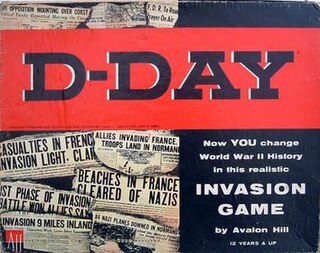
D-Day is a board wargame published by Avalon Hill in 1961 that simulates the six months of the European Campaign of World War II from the Normandy Invasion to the crossing of the Rhine. It was the first wargame to feature the now ubiquitous hex grid map and cardboard counters, and was revised and re-released in 1962, 1965, 1971, 1977 and 1991.

Air Assault on Crete is a wargame published by Avalon Hill in 1977 that simulates the Battle of Crete during World War II.

The Next War: Modern Conflict in Europe is a board wargame published by Simulations Publications, Inc. (SPI) in 1978 that simulates a hypothetical Warsaw Pact invasion of Western Europe.
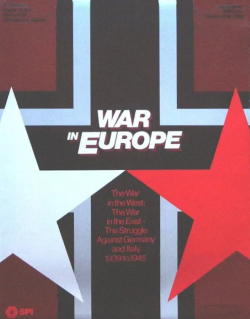
War in Europe is a grand strategic "monster" board wargame published by Simulations Publications Inc. (SPI) in 1976 that attempts to simulate the entirety of the European theatre of World War II from 1939 to 1945. One of the largest wargames ever produced, War in Europe features 4000 counters, four rulebooks, and nine maps that when placed together cover an area of 38.5 ft2. The game is nominally a three-player game, but each side can be represented by teams of players. SPI estimated the full game would take at least 180 hours.
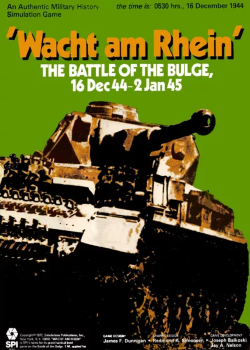
Wacht am Rhein is a grand tactical monster board wargame published by Simulations Publications, Inc. (SPI) in 1977 that simulates Germany's Battle of the Bulge offensive in late 1944 during World War II.
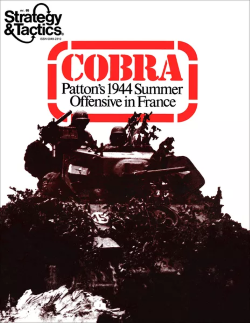
Cobra: Game of the Normandy Breakout, originally titled Cobra: Patton's 1944 Summer offensive in France, is a board wargame published by Simulations Publications Inc. (SPI) in 1977 that simulates the 1944 breakout of Allied forces from Normandy following D-Day.

Narvik: The Campaign in Norway, 1940 is a board wargame published by Game Designers' Workshop (GDW) in 1974 that simulates Operation Weserübung, the German invasion of Denmark and Norway during World War II. The game was one of the first in the Europa series of twenty interlocking games envisioned by GDW that would cover the entire European and North African theatres from the start to the end of World War II, using identical map scales and similar rules.

Dieppe, subtitled "An Operational Game of the Allied Raid on Fortress Europe, August 1942", is a board wargame published by Simulations Canada in 1977 that is a simulation of Operation Jubilee, the disastrous Dieppe Raid made by Canadian and British forces during World War II.
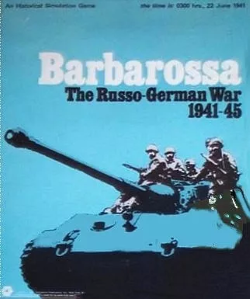
Barbarossa: The Russo-German War 1941–45 is a board wargame published by Simulations Publications Inc. (SPI) in 1969 that simulates the conflict between Germany and the Soviet Union on the Eastern Front of World War II. This was only SPI's second game produced during a preliminary round of "Test Series" games, and proved to be the most popular. Despite the title, taken from the German operational name for their initial invasion of the Soviet Union, the game covers the entire Eastern Front campaign from the German invasion in 1941 to the Fall of Berlin in 1945.

The Marne: Home Before the Leaves Fall is a board wargame published by Simulations Publications Inc. (SPI) in 1972 that is a strategic simulation of the First Battle of the Marne during World War I. The subtitle is attributed to Wilhelm II, who supposedly told German soldiers in August 1914 "You will be home before the leaves fall from the trees."

Combined Arms, subtitled "Combat Operations in the 20th Century", is a board wargame published by Simulations Publications Inc. (SPI) in 1974 that simulates various combat engagements in the mid-twentieth century

The Conquerors is a package of two board wargames published by Simulations Publications Inc. (SPI) in 1977. One game, The Macedonians, simulates the invasion of Persia by Alexander the Great, and the other, The Romans, covers the eastward expansion of the Roman Empire following the Second Punic War.

El Alamein: Battles in North Africa, 1942 is a board wargame published by Simulations Publications Inc. (SPI) in 1973 that simulates the final four months of the North African campaign during World War II.

Frederick the Great, subtitled "The Campaigns of The Soldier King 1756–1759", is a board wargame published by Simulations Publications Inc. (SPI) in 1975 that simulates several of the campaigns of Frederick the Great in Central Europe during the Seven Years' War. When SPI ran into financial difficulties, they sold the rights to the game to Avalon Hill, who produced a second edition in 1982.

Global War, subtitled "The War Against Germany and Japan, 1939–45", is a grand strategic and economic board wargame published by Simulations Publications Inc. (SPI) in 1975 that simulates the entire extent of World War II.

Overlord, subtitled "The Normandy Invasion", is a board wargame published by Conflict Games in 1973 that simulates the Normandy landings and the subsequent attempt by the Germans to prevent the Allies from breaking out of Normandy during World War II.

The Moscow Campaign, subtitled "Strike and Counterstrike Russia", is a board wargame published by Simulations Publications Inc. (SPI) in 1972 that simulates combat near Moscow during World War II.

Arnhem, subtitled "Operation Market-Garden, September 1944" and also published as A Bridge Too Far: Arnhem, is a board wargame published by Simulations Publications Inc. (SPI) in 1976 that simulates Operation Market Garden during World War II, when Allied forces attempted to create a salient in the Netherlands, using paratroopers to take strategic bridges over the Rhine. Arnhem was originally published in the WestWall "quadrigame", but was also packaged for sale as an individual game.

Normandy: The Invasion of Europe 1944 is a board wargame published by Simulations Publications Inc. (SPI) in 1969 that simulates the D-Day landings on the beaches of Normandy, and the six days that followed as the German forces tried to prevent an Allied break-out. A second revised edition was published in 1971




















